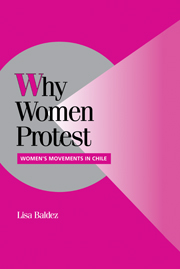Book contents
2 - MOTHERS OF THE COLD WAR, DAUGHTERS OF THE REVOLUTION: A HISTORICAL OVERVIEW OF WOMEN AND CHILEAN POLITICS
Published online by Cambridge University Press: 06 July 2010
Summary
Just like its counterparts elsewhere in the world, women's mobilization in Chile has been categorized primarily in terms of a first-wave suffrage movement in the first half of the twentieth century and a second-wave women's movement in the second half, with a period of relative quiescence in between. This chapter reexamines women's history in Chile and traces the relationship between women's organizations and political parties, starting with women's first attempts to vote in the late nineteenth century and ending with their participation in the student movements of the 1960s. This historical overview provides suggestive evidence for the central argument of the overall book, that the rise and fall of women's movements can be explained in terms of partisan realignment and gendered framing. In Chile, an independent women's movement emerged during the 1930s as the main cleavage in party politics shifted from religion to class. In 1953, the women's movement became tainted by scandal and collapsed suddenly, paving the way for parties to monopolize women's political involvement. The political incorporation of women during this period set the stage for the reemergence of autonomous women's mobilization in the 1970s and 1980s.
Realignment and the Rise of the Women's Suffrage Movement
This account of women's incorporation into the Chilean political system begins in November 1875, in San Felipe, a small town sixty miles north of Santiago. By a vote of four to one, the Electoral Registry Board of San Felipe decided to allow Señora Domitila Silva y Lepe, the widow of a former provincial governor, to register to vote.
- Type
- Chapter
- Information
- Why Women ProtestWomen's Movements in Chile, pp. 21 - 46Publisher: Cambridge University PressPrint publication year: 2002

